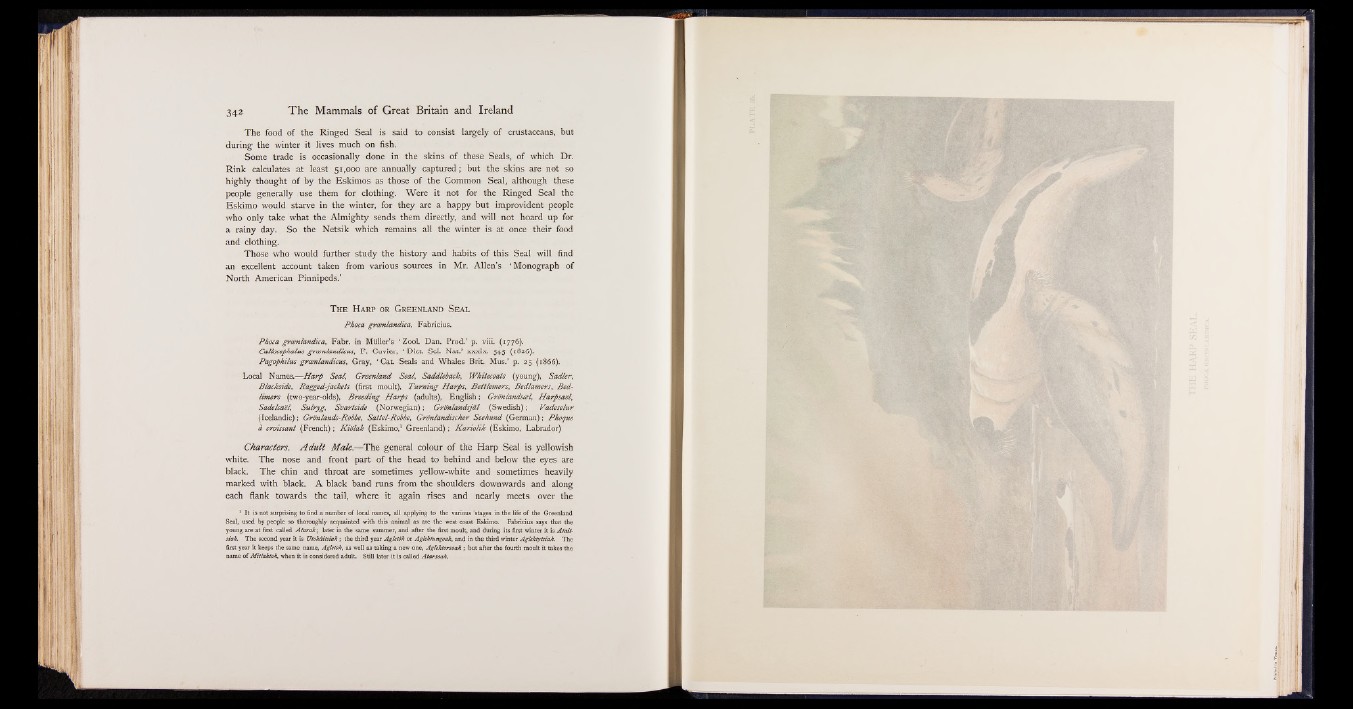
The food of the Ringed Seal is said to consist largely of crustaceans, but
during the winter it lives much on fish.
Some trade is occasionally done in the skins of these Seals, of which Dr.
Rink calculates at least 51,000 are annually captured; but the skins are not so
highly thought of by the Eskimos as those of the Common Seal, although these
people generally use them for clothing. Were it not for the Ringed Seal the
Eskimo would starve in the winter, for they are a happy but improvident people
who only take what the Almighty sends them directly, and will not hoard up for
a rainy day. So the Netsik which remains all the winter is at once their food
and clothing.
Those who would further study the history and habits of this Seal will find
an excellent account taken from various sources in Mr. Allen’s ‘ Monograph of
North American Pinnipeds.’
T h e H a r p o r G r e e n l a n d S e a l
Phoca grcenlandica, Fabricius.
Phoca grcenlandica, Fabr. in Muller’s ‘ Zool. Dan. Prod.’ p. viii. (1776).
Callocephalus green la n die us, F. Cuvier, ‘ Diet. Sei. Nat.’ xxxix. 545 (1826).
Pagophilus grcenlandicus, Gray, ‘ Cat. Seals and Whales Brit. Mus.’ p. 25 (1866).
Local Names.— Harp Seal, Greenland Seal, Saddleback, Whitecoats (young), Sadler,
Blackside, Ragged-jackets (first moult), Turning Harps, Bettlem ers, Bedlamers, Bed-
linters (two-year-olds), Breeding Harps (adults), English; Grönlandseel, Harpsael,
Sadelsa'el, Sulryg, Svartside (Norwegian); Grönlandsjäl (Swedish); Vadeselur
(Icelandic); Grönlands-Robbe, Sattel-Robbe, Grönländischer Seehund (German); Phoque
ä croissant (French); K iö la k (Eskimo,1 Greenland) ; K a rio lik (Eskimo, Labrador)
Characters. A d u lt Male.— The general colour of the Harp Seal is yellowish
white. The nose and front part of the head to behind and below the eyes are
black. The chin and throat are sometimes yellow-white and sometimes heavily
marked with black. A black band runs from the shoulders downwards and along
each flank towards the tail, where it again rises and nearly meets over the
1 It is not surprising to find a number of local names, all applying to the various 'stages in the life of the Greenland
Seal, used by people so thoroughly acquainted with this animal as are the west coast Eskimo. Fabricius says that the
young are at first called Atarak; later in the same summer, and after the first moult, and during its first winter it is Atait-
siak. The second year it is Utok&itsiak; the third year Agletdk or Aglektungoak, and in the third winter Aglektytsiak. The
first year it keeps the same name, Agletok, as well as taking a new one, Aglektorsoak; but after the fourth moult it takes the
name of Mitldktok, when it is considered adult. Still later it is called Atarsoak.